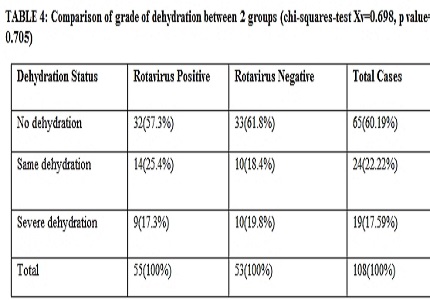Prevalence and outcome of rotaviral diarrhoea among children under five years- a single centre study
Abstract
Introduction: Diarrhoea refers to the passage of loose or watery stools or an increased frequency of stools for the child and occurs at some point in the life of nearly every child. Diarrhoea is not a disease, but is a symptom of a number of illnesses. Diarrhoea is common and rarely serious. It can lead to dehydration, which alters the child's natural balance of water, and to electrolyte (sodium, potassium, chloride) imbalance. It can be serious if not treated promptly.
Material & method: This prospective observational cohort study done 3 different hospitals in Hyderabad. The stool samples were collected and immunochromatographic test done to detect the rotavirus and ELISA done to detect the strain.
Results: The 108 patients were tested for rotavirus antigen. The highest incidence (38.6%) of rota viral diarrhoea is seen in children in age group of 0-12 months. Fifty-five (50.93%) patients were positive for the immunochromatographic test. Rotavirus infections were most common during the months from December to March. The male predominance was obtained in incidence of rota viral diarrhoea during this study. In only 17.3% cases with acute diarrhoea had severe dehydration requiring admission and intra-venous fluid therapy. The most common strain was G1P. All patients immunized with rotavirus vaccine are protected from rotaviral diarrhoea.
Conclusion: Study revealed maximum prevalence of rota viral diarrhoea in month from December to March. All vaccinated children with rota virus vaccine were protected from rota viral infection.
Downloads
References
2. Million Death Study Collaborators, Bassani DG, Kumar R, Awasthi S, Morris SK, Paul VK, et al. Causes of neonatal and child mortality in India :a nationally representative mortality survey.Lancet.2010;376:185360.
3. Bhan MK. Accelerated progress to reduce under-5 mortality in India. Lancet Glob Health. 2013 Oct;1(4):e172-3. doi: 10.1016/S2214-109X(13)70076-7. Epub 2013 Sep 19. [PubMed]
4. Kelkar SD, Purohit SG, Boralkar AN, Verma SP. Prevalence of rotavirus diarrhea among outpatients and hospitalized patients: a comparison. Southeast Asian J Trop Med Public Health. 2001 Sep;32(3):494-9.
5. Kahn G, Fitzwater S, Tate J, Kang G, Ganguly N, Nair G, Steele D, Arora R, Chawla-Sarkar M, Parashar U, Santosham M. Epidemiology and prospects for prevention of rotavirus disease in India. Indian Pediatr. 2012 Jun;49(6):467-74. [PubMed]
6. Kang G, Arora R, Chitambar SD, Deshpande J, Gupte MD, Kulkarni M, Naik TN, Mukherji D, Venkatasubramaniam S, Gentsch JR, Glass RI, Parashar UD. Indian Rotavirus Strain Surveillance Network. Multicenter, hospital-based surveillance of rotavirus disease and strains among indian children aged <5 years. J Infect Dis. 2009 Nov 1;200 Suppl 1:S147-53. doi: 10.1086/605031.
7. World Health Organization. The Treatment of Diarrhea: A Manual for Physicians and Other Senior Health Workers, 4th ed. Geneva: World Health Organization, 2005 (http://www.who.int/childadolescent)health/New_Publications/CHILD_HEALTH/ISBN_92_4_159318_0.pdf).
8. Bresee J, Parashar U, Holman R, Gentsch J, Glass R. Generic protocols for (i) hospitalbased surveillance to estimate the burden of rotavirus gastroenteritis in children and (ii) a communitybased survey on utilization of health care services for gastroenteritis in children. Document WHO/V&B/02.15.Geneva: World Health Organization, 2002:167.
9. Nair GB, Ramamurthy T, Bhattacharya MK, Krishnan T, Ganguly S, Saha DR, et al. Emerging trends in the etiology of enteric pathogens as evidenced from an active surveillance of hospitalized diarrhoeal patients in Kolkata, India. Gut Pathog. 2010;2:4.
10. Centers for Disease Control and Prevention (CDC). Rotavirus surveillanceworldwide, 20012008. MMWR Morb Mortal Wkly Rep. 2008;57:12557.
11. Sachdev HP, Kumar S, Singh KK, Satyanarayana L, Puri RK. Risk factors for fatal diarrhea in hospitalized children in India. J Pediatr Gastroenterol Nutr. 1991;12:7681.
12. Phukan AC, Patgiri DK, Mahanta J. Rotavirus associated acute diarrhoea in hospitalized children in Dibrugarh, Norteast India. Indian J Pathol Microbiol. 2003;46:2748.

Copyright (c) 2017 Author (s). Published by Siddharth Health Research and Social Welfare Society

This work is licensed under a Creative Commons Attribution 4.0 International License.


 OAI - Open Archives Initiative
OAI - Open Archives Initiative


